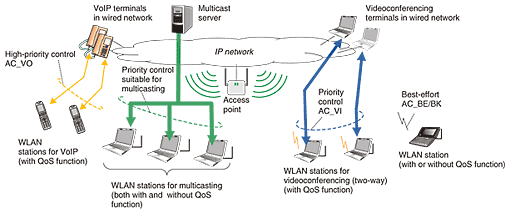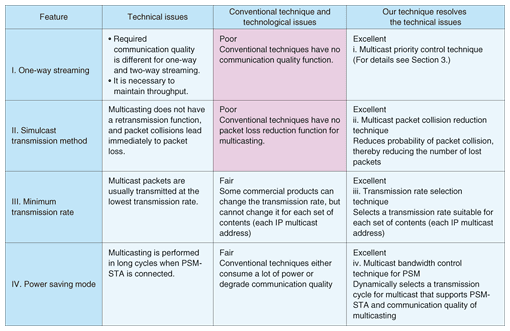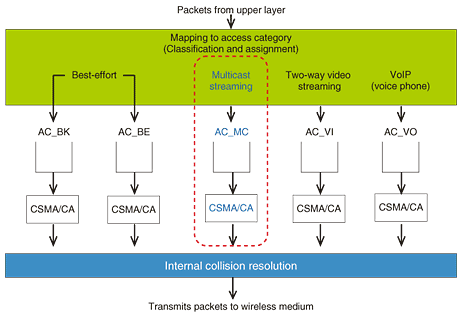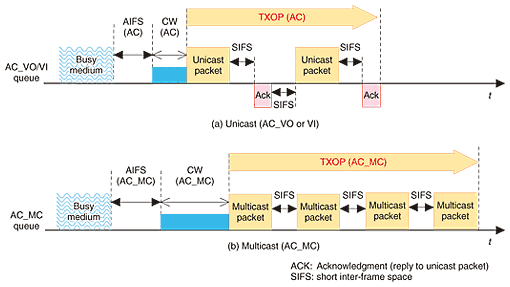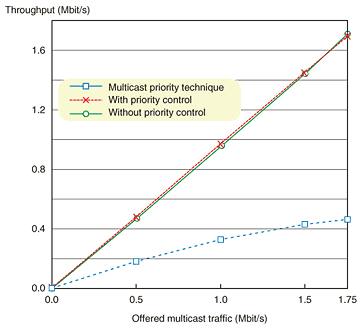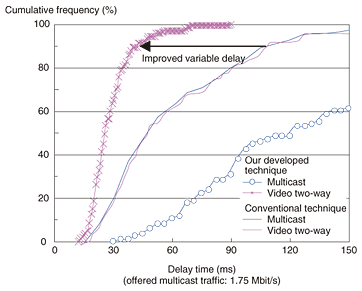 |
|||||||
|
|
|||||||
Vol. 5, No. 11, pp. 54–59, Nov. 2007. https://doi.org/10.53829/ntr200711sf9 Priority Control Techniques Suitable for Multicast Delivery on WLANsAbstractWe introduce techniques for maintaining communication quality for multicast delivery over wireless local area networks. These techniques simultaneously satisfy communication quality for multicasting and other multimedia applications (such as voice and video telephony).
1. IntroductionDemand for multimedia services such as voice and video streaming over wireless local area networks (WLANs) is increasing in homes, offices, and public places. Multimedia service requires high communication quality and will need functions for controlling and guaranteeing the quality of service (QoS). Standardized functions for WLANs include IEEE 802.11e [1] and Wi-Fi Multimedia (WMM). An amendment to be specified by IEEE 802.11e will provide an enhanced distributed channel access (EDCA) mechanism to support QoS functions. The EDCA mechanism prioritizes QoS by changing the access parameters, allowing each station (STA) and access point (AP) to have four priority levels (access categories or ACs). The incoming packets are mapped to one of four AC queues (classified and assigned to ACs) suitable for the priority of applications. Per-AC queues formulate the access priority control basis using the carrier sense multiple access with collision avoidance (CSMA/CA) algorithm. When the EDCA mechanism is used by a WLAN, users will have clear reception of many kinds of multimedia applications over an IP (Internet protocol) network such as voice over IP (VoIP) phone service or video streaming (videoconferencing and video telephony). Video delivery via the Internet using multicast transmission is one example of a multimedia application. Multicast transmission will be able to provide the same video streaming contents to multiple STAs simultaneously and is suitable for providing realtime video streaming over wide areas such as concert halls, racetracks, and sports stadiums. It will be an effective method of wireless transmission because WLANs share wireless bandwidth with all connected STAs. Here, we report on priority control techniques suitable for multicast transmission on WLANs. These are novel techniques based on the EDCA mechanism and maintain multicast communication quality such as video streaming even if there is heavy utilization of the wireless bandwidth. For example, the priority control techniques suitable for multicast transmission simultaneously satisfy communication quality for multicasting and support other multimedia applications (such as VoIP and video conferencing), as shown in Fig. 1.
2. Technical issues and features of WLANs with multicast transmissionMulticasting has the following four technical issues and features when it is used on IEEE802.11 WLANs. (1) One-way streaming Multicast transmission is one-way (uplink/downlink) streaming. The delay of one-way video streaming will usually be allowed to be more than ten times longer than that of two-way (bidirectional) video streaming because the fixed and variable delays of one-way video streaming will be adequately absorbed by the application jitter buffer. Therefore, multicast video streaming is assumed to be insensitive to delay time. However, regardless of the delay, the multicast communication bandwidth (throughput) must still be maintained. Therefore, because the communication qualities required by one-way and two-way streaming, even for the same video streaming, are different, we need priority control techniques that are suitable for this application. (2) Access control using the simulcast transmission method In a WLAN, packets simultaneously transmitted from two or more STAs tend to collide because WLANs use distributed access control. For unicast packets of a one-to-one communication, however, packet loss is very uncommon because packets that collide are recovered by the MAC (medium access control) layer using the retransmission control function. In multicast transmission of one-to-many communication, in contrast, packet collision leads immediately to packet loss because multicasting does not have a retransmission control function. Therefore, it will be difficult to ensure multicast transmission when multicast packets are sent from APs in crowded wireless networks. (3) Minimum transmission rate WLANs usually transmit multicast packets using the lowest wireless transmission rate supported in the WLAN°«s communication area. Furthermore, all of the video content is assigned the same wireless transmission rate. It is difficult to maintain multicast communication quality, and wireless bandwidth is consumed unnecessarily when content with a bit rate higher than the wireless transmission rate is transferred. (4) Multicast transmission suitable for power saving function Finally, IEEE802.11 WLANs have a power saving mode (PSM) to limit battery consumption. Generally, STAs that operate in PSM suspend the operation of the transceiver devices (sleep state), which reduces the battery consumption. To receive packets, all the PSM-STAs switch the transceiver device from the sleep state to the awake state with the same cycle. Therefore, to save a lot of power, it is necessary to lengthen the cycle on which transceiver devices run. The AP transmits multicast packets based on the time needed to run an STA transceiver device. However, excess delay and buffer overflow in the AP cause packet loss, which degrades multicast communication quality when multicasting is transmitted on a long cycle. A technique for stable multicast transmission is required when PSM-STAs are connected to the AP. 3. Priority control technique suitable for multicast transmission on WLANsThe priority control techniques suitable for multicast transmission and the ways they resolve the technical issues of multicast transmission are shown in Table 1. These techniques are described below: i. Multicast priority control ii. Multicast packet collision reduction iii. Transmission rate selection iv. Multicast bandwidth control for PSM
Here, we focus on multicast priority control (i). This technique guarantees communication quality and supports two-way streaming, such as VoIP and video conferencing. It has an extra AC for multicasting (AC_MC) in addition to the existing ACs, as shown in Fig. 2. The multicast packets are classified and assigned to AC_MC. The AC_MC priority access parameter is set to a value equal to or lower than those of AC_BE (best effort) and AC_BK (background). That is to say, the priority for AC_MC is set lower than that for AC_VI (video), which treats the same kind of video application (here, packets for two-way streaming are classified and assigned to AC_VI.).
An example of the access procedure is shown in Fig. 3. AC_MC senses the carrier in the wireless channel being used before it sends packets. The access parameters (arbitration inter-frame space (AIFS) or contention window (CW)) needed to sense the carrier are assigned large values, as shown in Fig. 3(b). The AIFS and CW values for AC_VI (high priority) are smaller than those for AC_MC (low priority). With this setting, voice and video applications with access categories AC_VO and AC_VI (shown in Fig. 3(a)) that are sensitive to fixed and variable delays will be able to acquire a transmission opportunity with a high probability and keep the delay to a minimum without being influenced by sending multicast packets. Although the fixed and variable multicast delays will increase because the access parameter for AC_MC is assigned a low priority, AC_MC will be able to transmit multicast packets continuously by extending the length of the optimal TXOP period. This technique will maintain the throughput (bandwidth) for multicast transmission. This is how multicast priority is controlled.
Simulation results for the multicast priority control technique are shown in Figs. 4 and 5. In the computer simulation scenario, the AP generated multicast traffic (0 to 1.75 Mbit/s) to STAs. At the same time, APs and the other STAs sent and received two-way video streaming traffic (each downlink and uplink was 1.75 Mbit/s). The other STA created a saturated wireless band environment by generating a background best-effort load. We chose a wireless transmission rate of 11 Mbit/s (IEEE802.11b) for our evaluation.
The multicast throughput characteristics of our technique (multicast priority control technique), of the conventional technique with priority control (with EDCA mechanism), and of the conventional technique without priority control (without EDCA mechanism) are compared in Fig. 4. In the computer simulation evaluation, the conventional technique with priority control identified the multicast and two-way video streaming as the same video streaming, so these applications were classified and assigned to AC_VI. The throughput of the multicasting was mostly maintained when our technique and the conventional technique with priority control were used. The cumulative delay time frequency of the video two-way streaming was obtained for both our technique and the conventional technique with priority control. The results are shown in Fig. 5. Although the fixed and variable delays of the video two-way streaming increased when the conventional technique with priority control was used, the fixed delay was kept to a minimum when our new technique and variable delay was used. These results indicate that although the multicast priority control technique provides few opportunities for multicast transmission, it can provide high-probability transmission opportunities for two-way video streaming and keep the low delay time. Furthermore, multicast throughput is maintained by extending the length of the optimal TXOP period. 4. Future workThe priority control techniques described in this article simultaneously satisfy communication quality for multicasting and other multimedia applications (such as voice and video telephony). We expect to create highly desirable services with these techniques in the future. References
|
|||||||








